Working Capital & SME Liquidity
VerifiedAdded on 2020/01/07
|57
|20980
|337
Report
AI Summary
This report investigates the importance of working capital management in enhancing the liquidity of small and medium-sized enterprises (SMEs). A case study of Oakman Inns & Restaurants in the UK is used to explore this relationship. The report uses a descriptive research design with an inductive approach and interpretivist philosophy. Data was collected through questionnaires and interviews with 10 employees in the finance department, supplemented by secondary data from literature reviews and company reports. Thematic analysis revealed key findings: most respondents highlighted working capital's contribution to profitability; timely production and sales were crucial for achieving business objectives; forecasting cash flow was a key method for determining working capital; and price fluctuations were a major challenge. The report concludes that effective working capital management is vital for SME liquidity and profitability, offering recommendations such as shorter operating cycles, tighter credit control, and long-term investment strategies for surplus capital. The study acknowledges limitations related to time and resources and suggests further research into the impact of working capital on SME profitability.
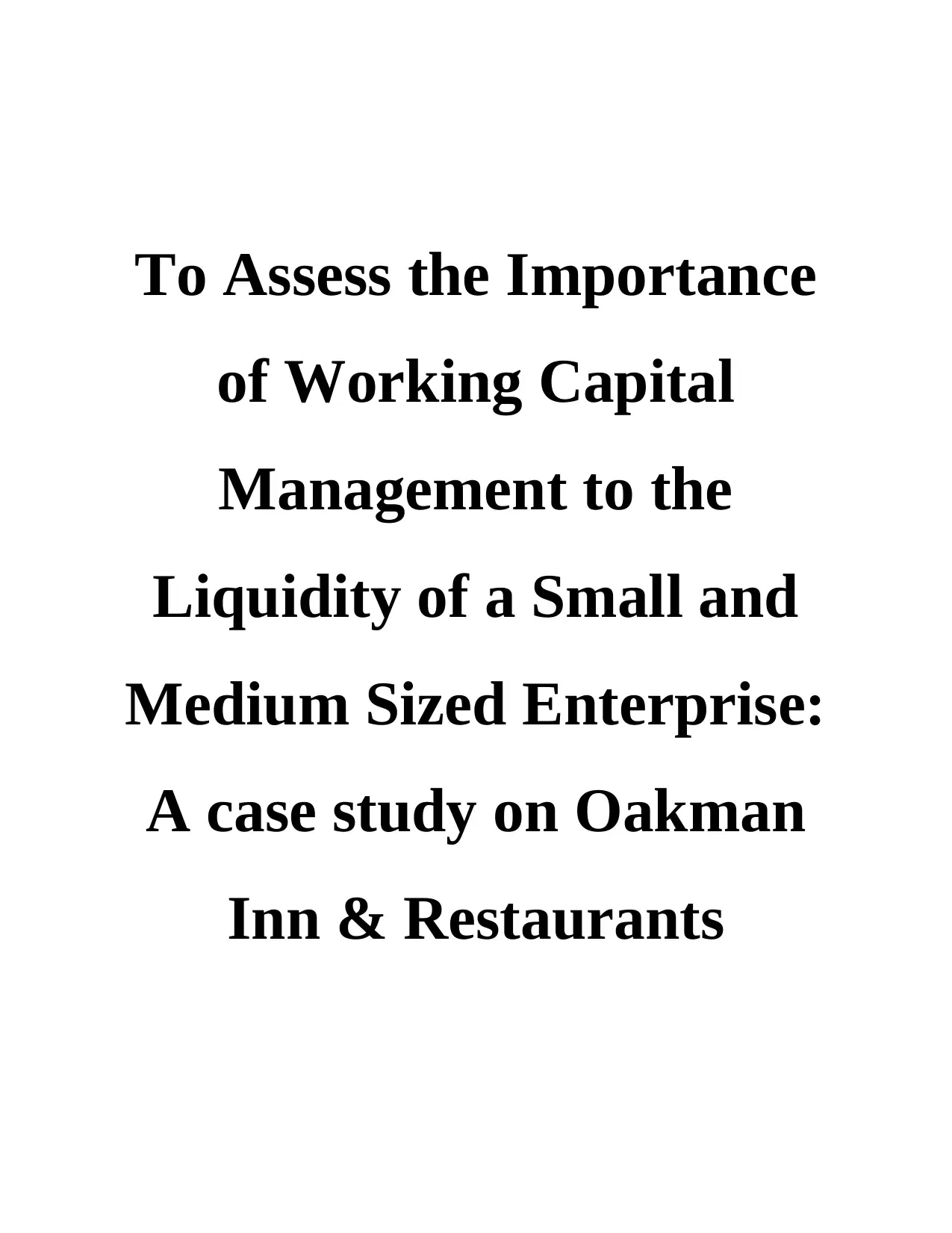
To Assess the Importance
of Working Capital
Management to the
Liquidity of a Small and
Medium Sized Enterprise:
A case study on Oakman
Inn & Restaurants
of Working Capital
Management to the
Liquidity of a Small and
Medium Sized Enterprise:
A case study on Oakman
Inn & Restaurants
Paraphrase This Document
Need a fresh take? Get an instant paraphrase of this document with our AI Paraphraser
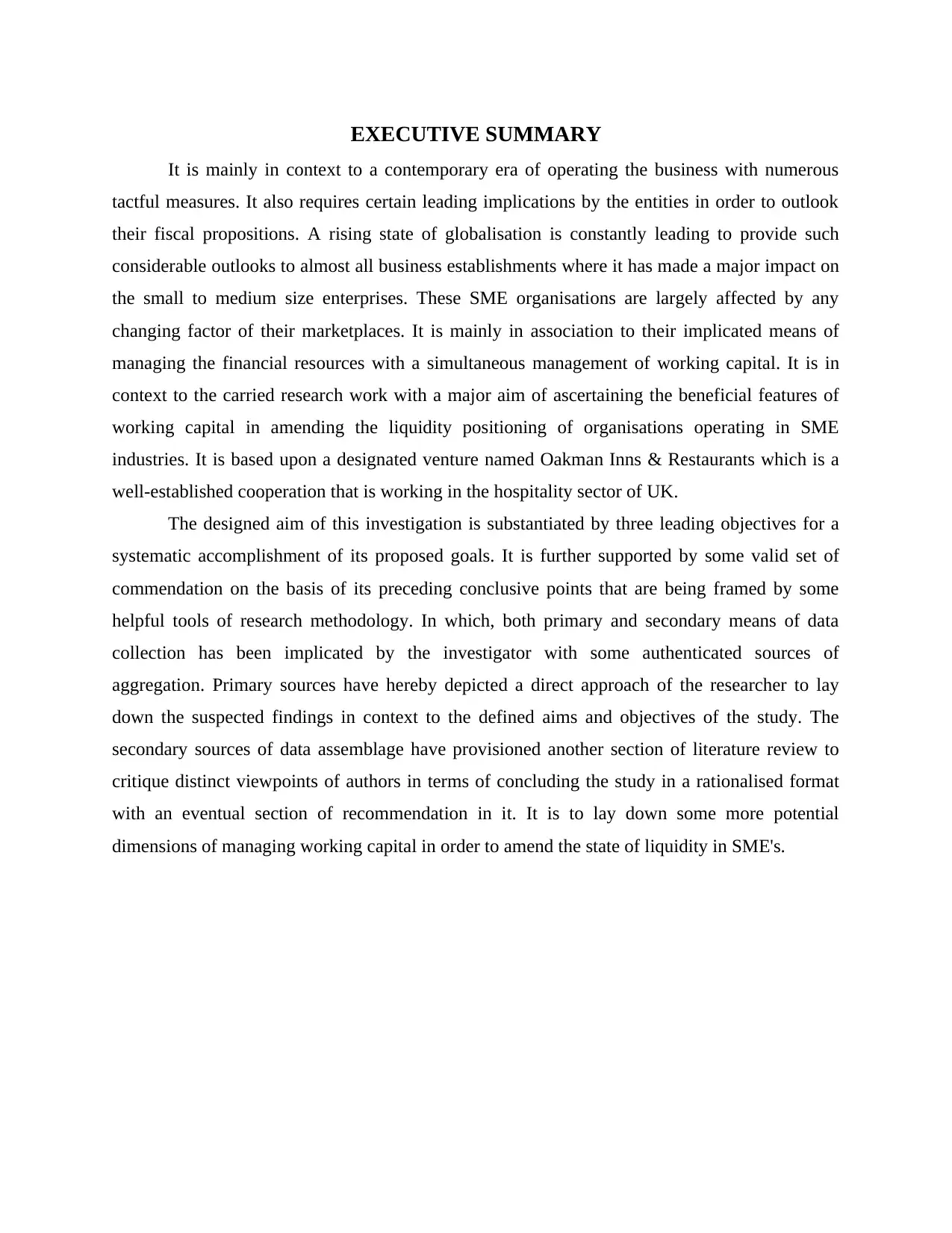
EXECUTIVE SUMMARY
It is mainly in context to a contemporary era of operating the business with numerous
tactful measures. It also requires certain leading implications by the entities in order to outlook
their fiscal propositions. A rising state of globalisation is constantly leading to provide such
considerable outlooks to almost all business establishments where it has made a major impact on
the small to medium size enterprises. These SME organisations are largely affected by any
changing factor of their marketplaces. It is mainly in association to their implicated means of
managing the financial resources with a simultaneous management of working capital. It is in
context to the carried research work with a major aim of ascertaining the beneficial features of
working capital in amending the liquidity positioning of organisations operating in SME
industries. It is based upon a designated venture named Oakman Inns & Restaurants which is a
well-established cooperation that is working in the hospitality sector of UK.
The designed aim of this investigation is substantiated by three leading objectives for a
systematic accomplishment of its proposed goals. It is further supported by some valid set of
commendation on the basis of its preceding conclusive points that are being framed by some
helpful tools of research methodology. In which, both primary and secondary means of data
collection has been implicated by the investigator with some authenticated sources of
aggregation. Primary sources have hereby depicted a direct approach of the researcher to lay
down the suspected findings in context to the defined aims and objectives of the study. The
secondary sources of data assemblage have provisioned another section of literature review to
critique distinct viewpoints of authors in terms of concluding the study in a rationalised format
with an eventual section of recommendation in it. It is to lay down some more potential
dimensions of managing working capital in order to amend the state of liquidity in SME's.
It is mainly in context to a contemporary era of operating the business with numerous
tactful measures. It also requires certain leading implications by the entities in order to outlook
their fiscal propositions. A rising state of globalisation is constantly leading to provide such
considerable outlooks to almost all business establishments where it has made a major impact on
the small to medium size enterprises. These SME organisations are largely affected by any
changing factor of their marketplaces. It is mainly in association to their implicated means of
managing the financial resources with a simultaneous management of working capital. It is in
context to the carried research work with a major aim of ascertaining the beneficial features of
working capital in amending the liquidity positioning of organisations operating in SME
industries. It is based upon a designated venture named Oakman Inns & Restaurants which is a
well-established cooperation that is working in the hospitality sector of UK.
The designed aim of this investigation is substantiated by three leading objectives for a
systematic accomplishment of its proposed goals. It is further supported by some valid set of
commendation on the basis of its preceding conclusive points that are being framed by some
helpful tools of research methodology. In which, both primary and secondary means of data
collection has been implicated by the investigator with some authenticated sources of
aggregation. Primary sources have hereby depicted a direct approach of the researcher to lay
down the suspected findings in context to the defined aims and objectives of the study. The
secondary sources of data assemblage have provisioned another section of literature review to
critique distinct viewpoints of authors in terms of concluding the study in a rationalised format
with an eventual section of recommendation in it. It is to lay down some more potential
dimensions of managing working capital in order to amend the state of liquidity in SME's.
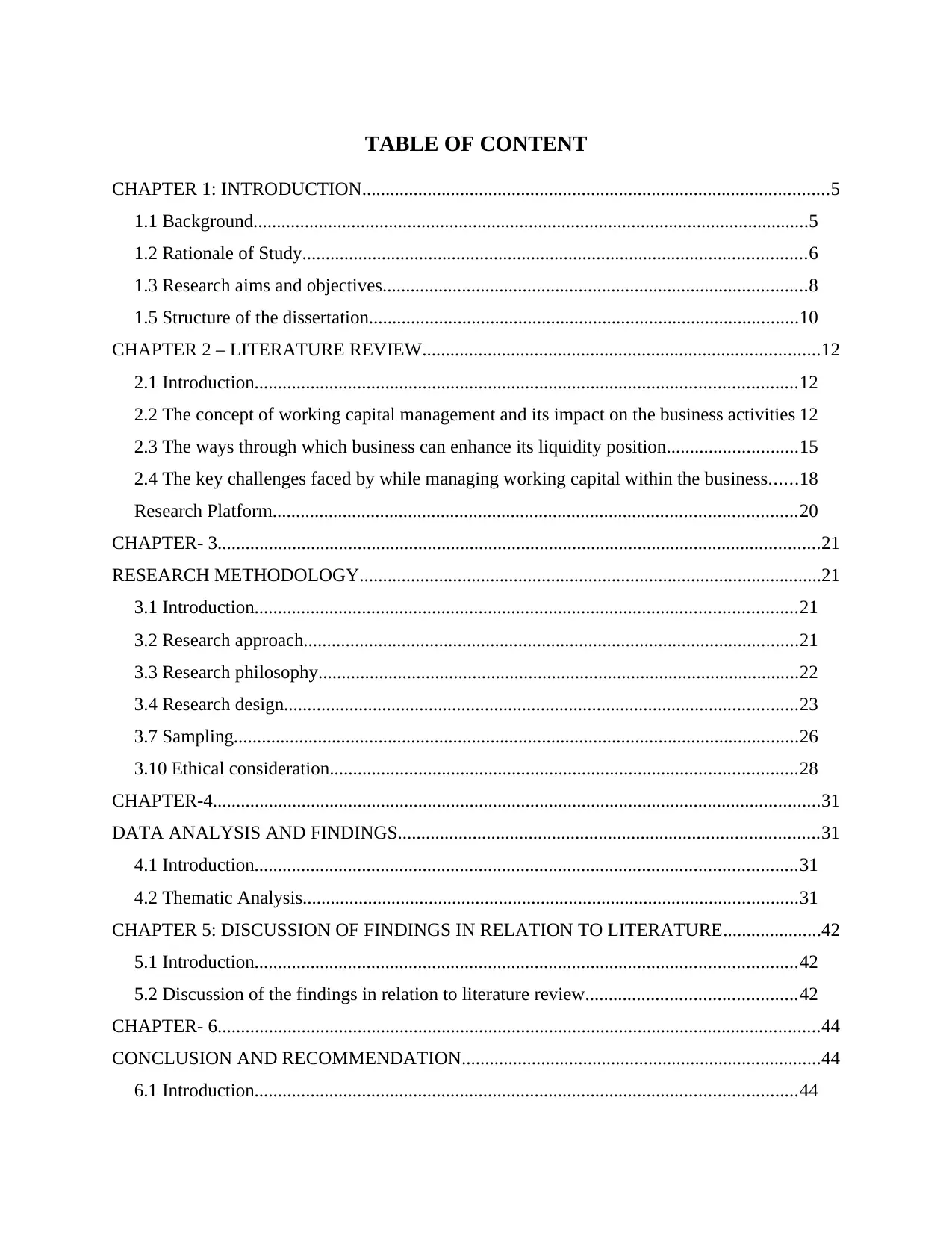
TABLE OF CONTENT
CHAPTER 1: INTRODUCTION....................................................................................................5
1.1 Background.......................................................................................................................5
1.2 Rationale of Study............................................................................................................6
1.3 Research aims and objectives...........................................................................................8
1.5 Structure of the dissertation............................................................................................10
CHAPTER 2 – LITERATURE REVIEW.....................................................................................12
2.1 Introduction....................................................................................................................12
2.2 The concept of working capital management and its impact on the business activities 12
2.3 The ways through which business can enhance its liquidity position............................15
2.4 The key challenges faced by while managing working capital within the business......18
Research Platform................................................................................................................20
CHAPTER- 3.................................................................................................................................21
RESEARCH METHODOLOGY...................................................................................................21
3.1 Introduction....................................................................................................................21
3.2 Research approach..........................................................................................................21
3.3 Research philosophy.......................................................................................................22
3.4 Research design..............................................................................................................23
3.7 Sampling.........................................................................................................................26
3.10 Ethical consideration....................................................................................................28
CHAPTER-4..................................................................................................................................31
DATA ANALYSIS AND FINDINGS..........................................................................................31
4.1 Introduction....................................................................................................................31
4.2 Thematic Analysis..........................................................................................................31
CHAPTER 5: DISCUSSION OF FINDINGS IN RELATION TO LITERATURE.....................42
5.1 Introduction....................................................................................................................42
5.2 Discussion of the findings in relation to literature review.............................................42
CHAPTER- 6.................................................................................................................................44
CONCLUSION AND RECOMMENDATION.............................................................................44
6.1 Introduction....................................................................................................................44
CHAPTER 1: INTRODUCTION....................................................................................................5
1.1 Background.......................................................................................................................5
1.2 Rationale of Study............................................................................................................6
1.3 Research aims and objectives...........................................................................................8
1.5 Structure of the dissertation............................................................................................10
CHAPTER 2 – LITERATURE REVIEW.....................................................................................12
2.1 Introduction....................................................................................................................12
2.2 The concept of working capital management and its impact on the business activities 12
2.3 The ways through which business can enhance its liquidity position............................15
2.4 The key challenges faced by while managing working capital within the business......18
Research Platform................................................................................................................20
CHAPTER- 3.................................................................................................................................21
RESEARCH METHODOLOGY...................................................................................................21
3.1 Introduction....................................................................................................................21
3.2 Research approach..........................................................................................................21
3.3 Research philosophy.......................................................................................................22
3.4 Research design..............................................................................................................23
3.7 Sampling.........................................................................................................................26
3.10 Ethical consideration....................................................................................................28
CHAPTER-4..................................................................................................................................31
DATA ANALYSIS AND FINDINGS..........................................................................................31
4.1 Introduction....................................................................................................................31
4.2 Thematic Analysis..........................................................................................................31
CHAPTER 5: DISCUSSION OF FINDINGS IN RELATION TO LITERATURE.....................42
5.1 Introduction....................................................................................................................42
5.2 Discussion of the findings in relation to literature review.............................................42
CHAPTER- 6.................................................................................................................................44
CONCLUSION AND RECOMMENDATION.............................................................................44
6.1 Introduction....................................................................................................................44
⊘ This is a preview!⊘
Do you want full access?
Subscribe today to unlock all pages.

Trusted by 1+ million students worldwide
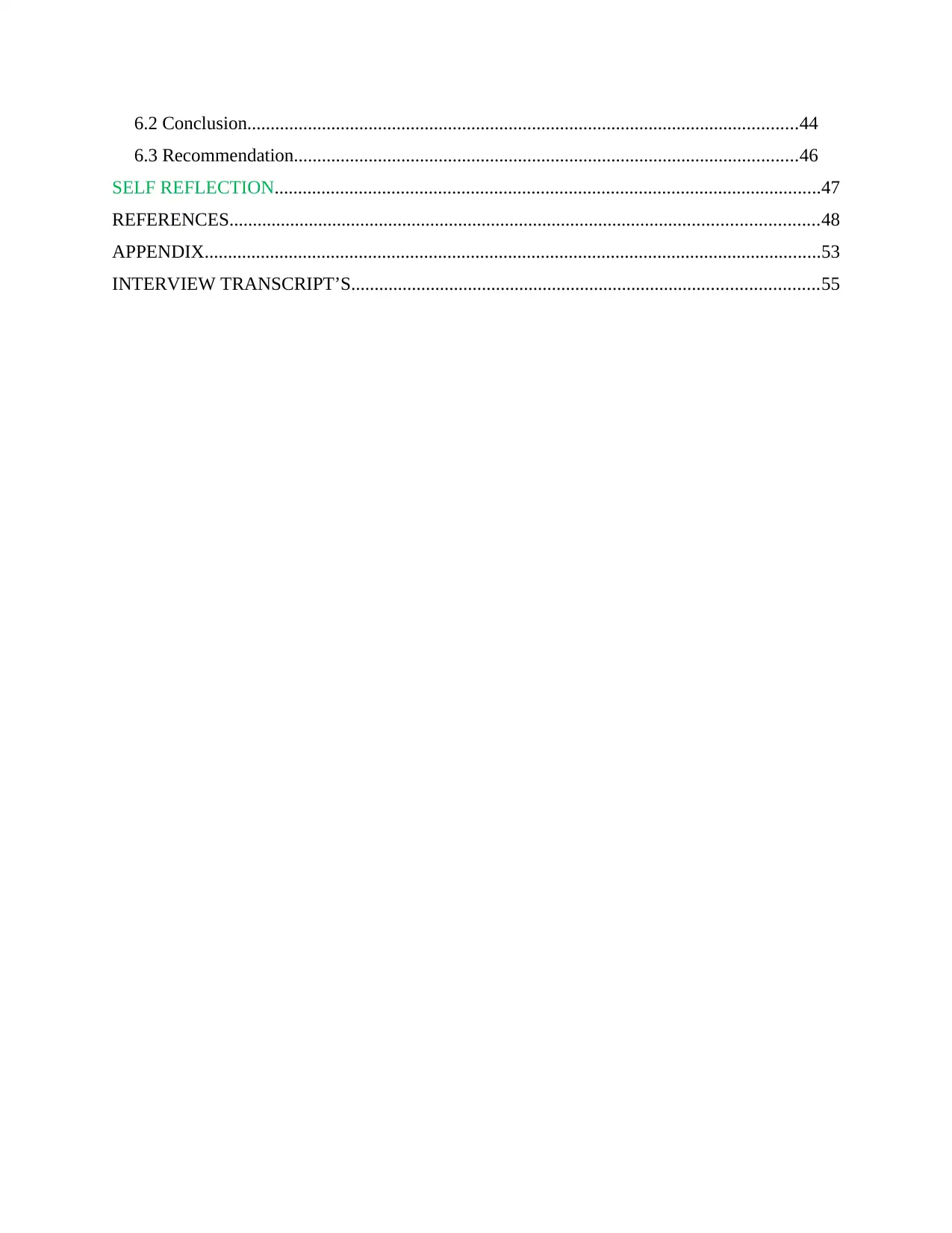
6.2 Conclusion......................................................................................................................44
6.3 Recommendation............................................................................................................46
SELF REFLECTION.....................................................................................................................47
REFERENCES..............................................................................................................................48
APPENDIX....................................................................................................................................53
INTERVIEW TRANSCRIPT’S....................................................................................................55
6.3 Recommendation............................................................................................................46
SELF REFLECTION.....................................................................................................................47
REFERENCES..............................................................................................................................48
APPENDIX....................................................................................................................................53
INTERVIEW TRANSCRIPT’S....................................................................................................55
Paraphrase This Document
Need a fresh take? Get an instant paraphrase of this document with our AI Paraphraser
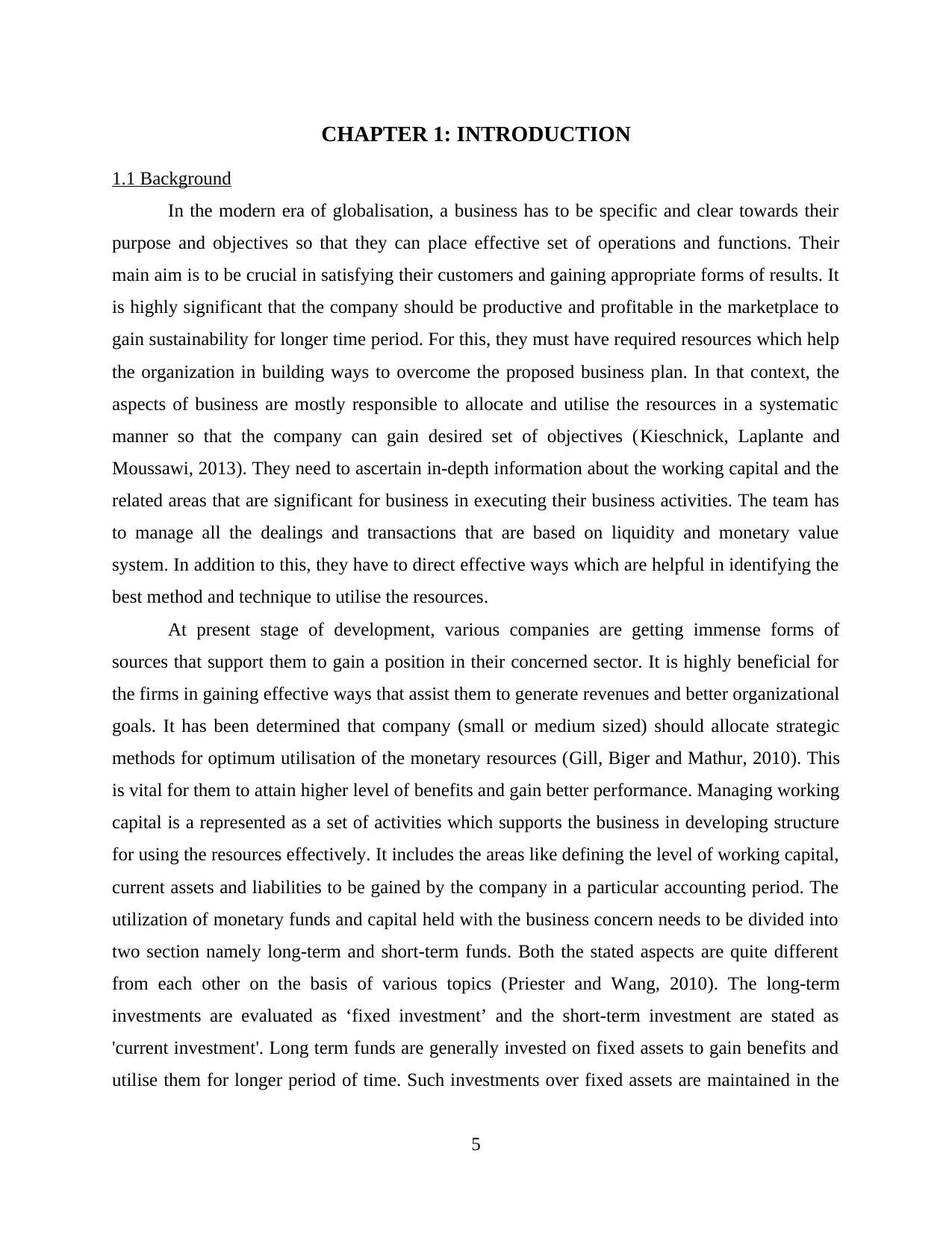
CHAPTER 1: INTRODUCTION
1.1 Background
In the modern era of globalisation, a business has to be specific and clear towards their
purpose and objectives so that they can place effective set of operations and functions. Their
main aim is to be crucial in satisfying their customers and gaining appropriate forms of results. It
is highly significant that the company should be productive and profitable in the marketplace to
gain sustainability for longer time period. For this, they must have required resources which help
the organization in building ways to overcome the proposed business plan. In that context, the
aspects of business are mostly responsible to allocate and utilise the resources in a systematic
manner so that the company can gain desired set of objectives (Kieschnick, Laplante and
Moussawi, 2013). They need to ascertain in-depth information about the working capital and the
related areas that are significant for business in executing their business activities. The team has
to manage all the dealings and transactions that are based on liquidity and monetary value
system. In addition to this, they have to direct effective ways which are helpful in identifying the
best method and technique to utilise the resources.
At present stage of development, various companies are getting immense forms of
sources that support them to gain a position in their concerned sector. It is highly beneficial for
the firms in gaining effective ways that assist them to generate revenues and better organizational
goals. It has been determined that company (small or medium sized) should allocate strategic
methods for optimum utilisation of the monetary resources (Gill, Biger and Mathur, 2010). This
is vital for them to attain higher level of benefits and gain better performance. Managing working
capital is a represented as a set of activities which supports the business in developing structure
for using the resources effectively. It includes the areas like defining the level of working capital,
current assets and liabilities to be gained by the company in a particular accounting period. The
utilization of monetary funds and capital held with the business concern needs to be divided into
two section namely long-term and short-term funds. Both the stated aspects are quite different
from each other on the basis of various topics (Priester and Wang, 2010). The long-term
investments are evaluated as ‘fixed investment’ and the short-term investment are stated as
'current investment'. Long term funds are generally invested on fixed assets to gain benefits and
utilise them for longer period of time. Such investments over fixed assets are maintained in the
5
1.1 Background
In the modern era of globalisation, a business has to be specific and clear towards their
purpose and objectives so that they can place effective set of operations and functions. Their
main aim is to be crucial in satisfying their customers and gaining appropriate forms of results. It
is highly significant that the company should be productive and profitable in the marketplace to
gain sustainability for longer time period. For this, they must have required resources which help
the organization in building ways to overcome the proposed business plan. In that context, the
aspects of business are mostly responsible to allocate and utilise the resources in a systematic
manner so that the company can gain desired set of objectives (Kieschnick, Laplante and
Moussawi, 2013). They need to ascertain in-depth information about the working capital and the
related areas that are significant for business in executing their business activities. The team has
to manage all the dealings and transactions that are based on liquidity and monetary value
system. In addition to this, they have to direct effective ways which are helpful in identifying the
best method and technique to utilise the resources.
At present stage of development, various companies are getting immense forms of
sources that support them to gain a position in their concerned sector. It is highly beneficial for
the firms in gaining effective ways that assist them to generate revenues and better organizational
goals. It has been determined that company (small or medium sized) should allocate strategic
methods for optimum utilisation of the monetary resources (Gill, Biger and Mathur, 2010). This
is vital for them to attain higher level of benefits and gain better performance. Managing working
capital is a represented as a set of activities which supports the business in developing structure
for using the resources effectively. It includes the areas like defining the level of working capital,
current assets and liabilities to be gained by the company in a particular accounting period. The
utilization of monetary funds and capital held with the business concern needs to be divided into
two section namely long-term and short-term funds. Both the stated aspects are quite different
from each other on the basis of various topics (Priester and Wang, 2010). The long-term
investments are evaluated as ‘fixed investment’ and the short-term investment are stated as
'current investment'. Long term funds are generally invested on fixed assets to gain benefits and
utilise them for longer period of time. Such investments over fixed assets are maintained in the
5
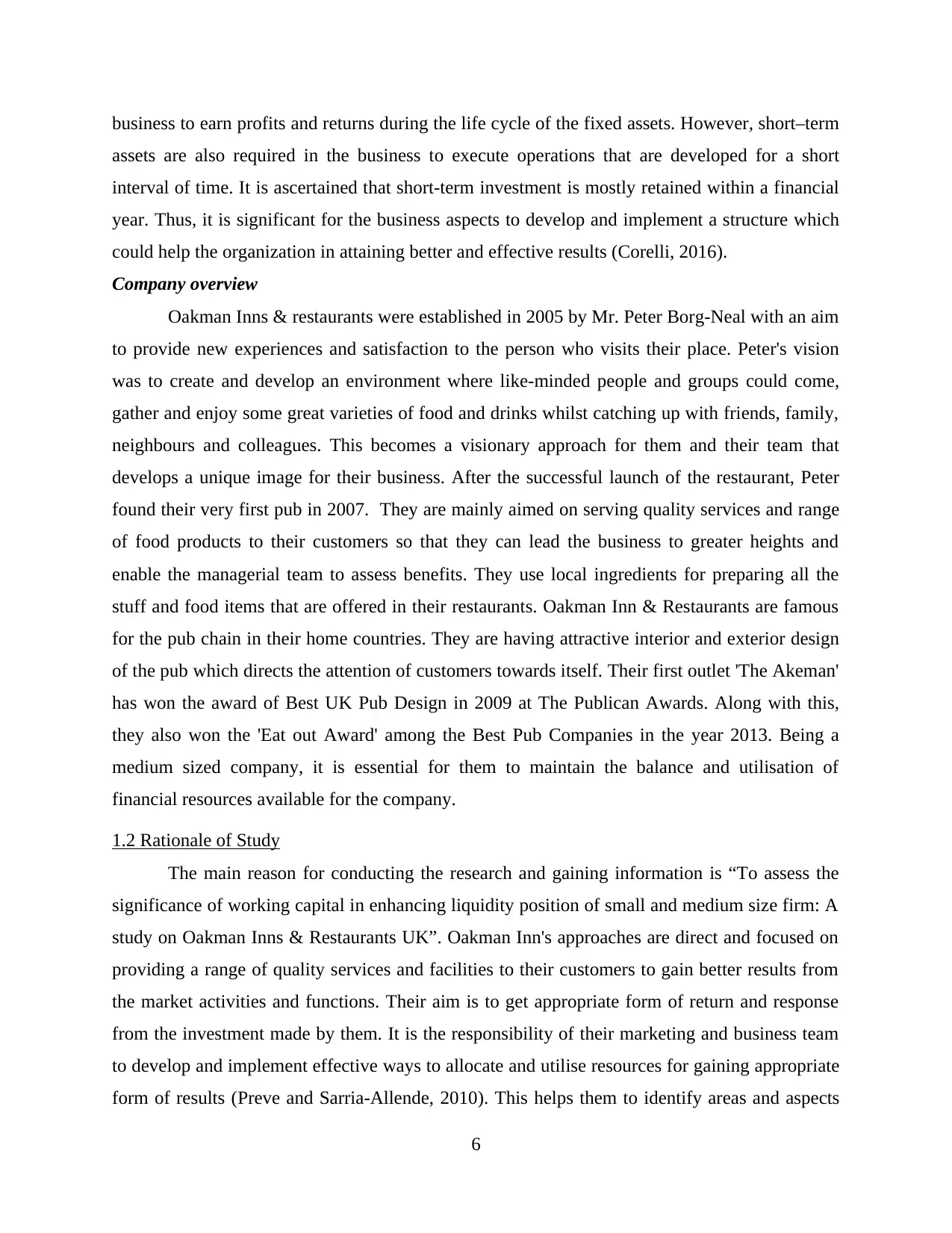
business to earn profits and returns during the life cycle of the fixed assets. However, short–term
assets are also required in the business to execute operations that are developed for a short
interval of time. It is ascertained that short-term investment is mostly retained within a financial
year. Thus, it is significant for the business aspects to develop and implement a structure which
could help the organization in attaining better and effective results (Corelli, 2016).
Company overview
Oakman Inns & restaurants were established in 2005 by Mr. Peter Borg-Neal with an aim
to provide new experiences and satisfaction to the person who visits their place. Peter's vision
was to create and develop an environment where like-minded people and groups could come,
gather and enjoy some great varieties of food and drinks whilst catching up with friends, family,
neighbours and colleagues. This becomes a visionary approach for them and their team that
develops a unique image for their business. After the successful launch of the restaurant, Peter
found their very first pub in 2007. They are mainly aimed on serving quality services and range
of food products to their customers so that they can lead the business to greater heights and
enable the managerial team to assess benefits. They use local ingredients for preparing all the
stuff and food items that are offered in their restaurants. Oakman Inn & Restaurants are famous
for the pub chain in their home countries. They are having attractive interior and exterior design
of the pub which directs the attention of customers towards itself. Their first outlet 'The Akeman'
has won the award of Best UK Pub Design in 2009 at The Publican Awards. Along with this,
they also won the 'Eat out Award' among the Best Pub Companies in the year 2013. Being a
medium sized company, it is essential for them to maintain the balance and utilisation of
financial resources available for the company.
1.2 Rationale of Study
The main reason for conducting the research and gaining information is “To assess the
significance of working capital in enhancing liquidity position of small and medium size firm: A
study on Oakman Inns & Restaurants UK”. Oakman Inn's approaches are direct and focused on
providing a range of quality services and facilities to their customers to gain better results from
the market activities and functions. Their aim is to get appropriate form of return and response
from the investment made by them. It is the responsibility of their marketing and business team
to develop and implement effective ways to allocate and utilise resources for gaining appropriate
form of results (Preve and Sarria-Allende, 2010). This helps them to identify areas and aspects
6
assets are also required in the business to execute operations that are developed for a short
interval of time. It is ascertained that short-term investment is mostly retained within a financial
year. Thus, it is significant for the business aspects to develop and implement a structure which
could help the organization in attaining better and effective results (Corelli, 2016).
Company overview
Oakman Inns & restaurants were established in 2005 by Mr. Peter Borg-Neal with an aim
to provide new experiences and satisfaction to the person who visits their place. Peter's vision
was to create and develop an environment where like-minded people and groups could come,
gather and enjoy some great varieties of food and drinks whilst catching up with friends, family,
neighbours and colleagues. This becomes a visionary approach for them and their team that
develops a unique image for their business. After the successful launch of the restaurant, Peter
found their very first pub in 2007. They are mainly aimed on serving quality services and range
of food products to their customers so that they can lead the business to greater heights and
enable the managerial team to assess benefits. They use local ingredients for preparing all the
stuff and food items that are offered in their restaurants. Oakman Inn & Restaurants are famous
for the pub chain in their home countries. They are having attractive interior and exterior design
of the pub which directs the attention of customers towards itself. Their first outlet 'The Akeman'
has won the award of Best UK Pub Design in 2009 at The Publican Awards. Along with this,
they also won the 'Eat out Award' among the Best Pub Companies in the year 2013. Being a
medium sized company, it is essential for them to maintain the balance and utilisation of
financial resources available for the company.
1.2 Rationale of Study
The main reason for conducting the research and gaining information is “To assess the
significance of working capital in enhancing liquidity position of small and medium size firm: A
study on Oakman Inns & Restaurants UK”. Oakman Inn's approaches are direct and focused on
providing a range of quality services and facilities to their customers to gain better results from
the market activities and functions. Their aim is to get appropriate form of return and response
from the investment made by them. It is the responsibility of their marketing and business team
to develop and implement effective ways to allocate and utilise resources for gaining appropriate
form of results (Preve and Sarria-Allende, 2010). This helps them to identify areas and aspects
6
⊘ This is a preview!⊘
Do you want full access?
Subscribe today to unlock all pages.

Trusted by 1+ million students worldwide
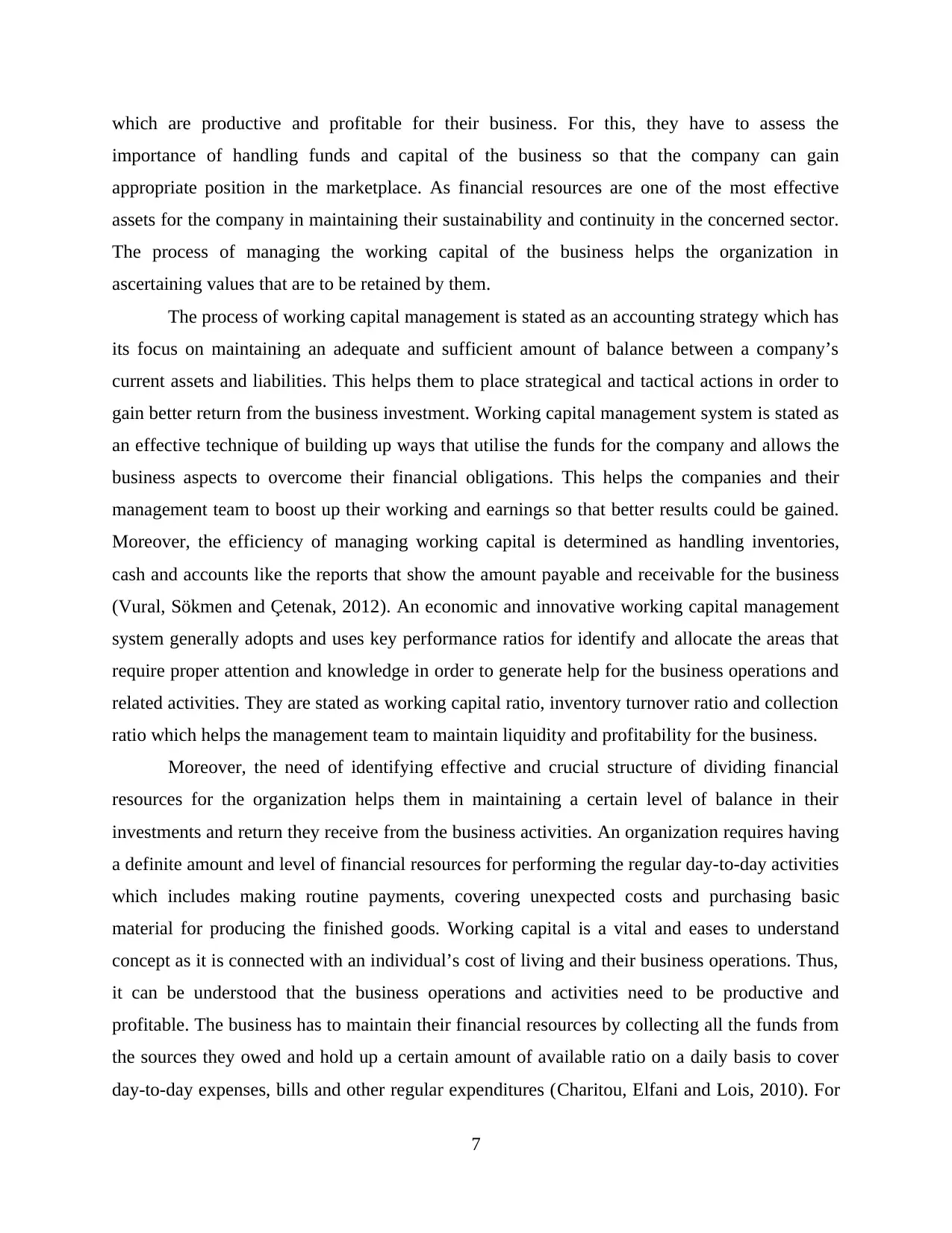
which are productive and profitable for their business. For this, they have to assess the
importance of handling funds and capital of the business so that the company can gain
appropriate position in the marketplace. As financial resources are one of the most effective
assets for the company in maintaining their sustainability and continuity in the concerned sector.
The process of managing the working capital of the business helps the organization in
ascertaining values that are to be retained by them.
The process of working capital management is stated as an accounting strategy which has
its focus on maintaining an adequate and sufficient amount of balance between a company’s
current assets and liabilities. This helps them to place strategical and tactical actions in order to
gain better return from the business investment. Working capital management system is stated as
an effective technique of building up ways that utilise the funds for the company and allows the
business aspects to overcome their financial obligations. This helps the companies and their
management team to boost up their working and earnings so that better results could be gained.
Moreover, the efficiency of managing working capital is determined as handling inventories,
cash and accounts like the reports that show the amount payable and receivable for the business
(Vural, Sökmen and Çetenak, 2012). An economic and innovative working capital management
system generally adopts and uses key performance ratios for identify and allocate the areas that
require proper attention and knowledge in order to generate help for the business operations and
related activities. They are stated as working capital ratio, inventory turnover ratio and collection
ratio which helps the management team to maintain liquidity and profitability for the business.
Moreover, the need of identifying effective and crucial structure of dividing financial
resources for the organization helps them in maintaining a certain level of balance in their
investments and return they receive from the business activities. An organization requires having
a definite amount and level of financial resources for performing the regular day-to-day activities
which includes making routine payments, covering unexpected costs and purchasing basic
material for producing the finished goods. Working capital is a vital and eases to understand
concept as it is connected with an individual’s cost of living and their business operations. Thus,
it can be understood that the business operations and activities need to be productive and
profitable. The business has to maintain their financial resources by collecting all the funds from
the sources they owed and hold up a certain amount of available ratio on a daily basis to cover
day-to-day expenses, bills and other regular expenditures (Charitou, Elfani and Lois, 2010). For
7
importance of handling funds and capital of the business so that the company can gain
appropriate position in the marketplace. As financial resources are one of the most effective
assets for the company in maintaining their sustainability and continuity in the concerned sector.
The process of managing the working capital of the business helps the organization in
ascertaining values that are to be retained by them.
The process of working capital management is stated as an accounting strategy which has
its focus on maintaining an adequate and sufficient amount of balance between a company’s
current assets and liabilities. This helps them to place strategical and tactical actions in order to
gain better return from the business investment. Working capital management system is stated as
an effective technique of building up ways that utilise the funds for the company and allows the
business aspects to overcome their financial obligations. This helps the companies and their
management team to boost up their working and earnings so that better results could be gained.
Moreover, the efficiency of managing working capital is determined as handling inventories,
cash and accounts like the reports that show the amount payable and receivable for the business
(Vural, Sökmen and Çetenak, 2012). An economic and innovative working capital management
system generally adopts and uses key performance ratios for identify and allocate the areas that
require proper attention and knowledge in order to generate help for the business operations and
related activities. They are stated as working capital ratio, inventory turnover ratio and collection
ratio which helps the management team to maintain liquidity and profitability for the business.
Moreover, the need of identifying effective and crucial structure of dividing financial
resources for the organization helps them in maintaining a certain level of balance in their
investments and return they receive from the business activities. An organization requires having
a definite amount and level of financial resources for performing the regular day-to-day activities
which includes making routine payments, covering unexpected costs and purchasing basic
material for producing the finished goods. Working capital is a vital and eases to understand
concept as it is connected with an individual’s cost of living and their business operations. Thus,
it can be understood that the business operations and activities need to be productive and
profitable. The business has to maintain their financial resources by collecting all the funds from
the sources they owed and hold up a certain amount of available ratio on a daily basis to cover
day-to-day expenses, bills and other regular expenditures (Charitou, Elfani and Lois, 2010). For
7
Paraphrase This Document
Need a fresh take? Get an instant paraphrase of this document with our AI Paraphraser
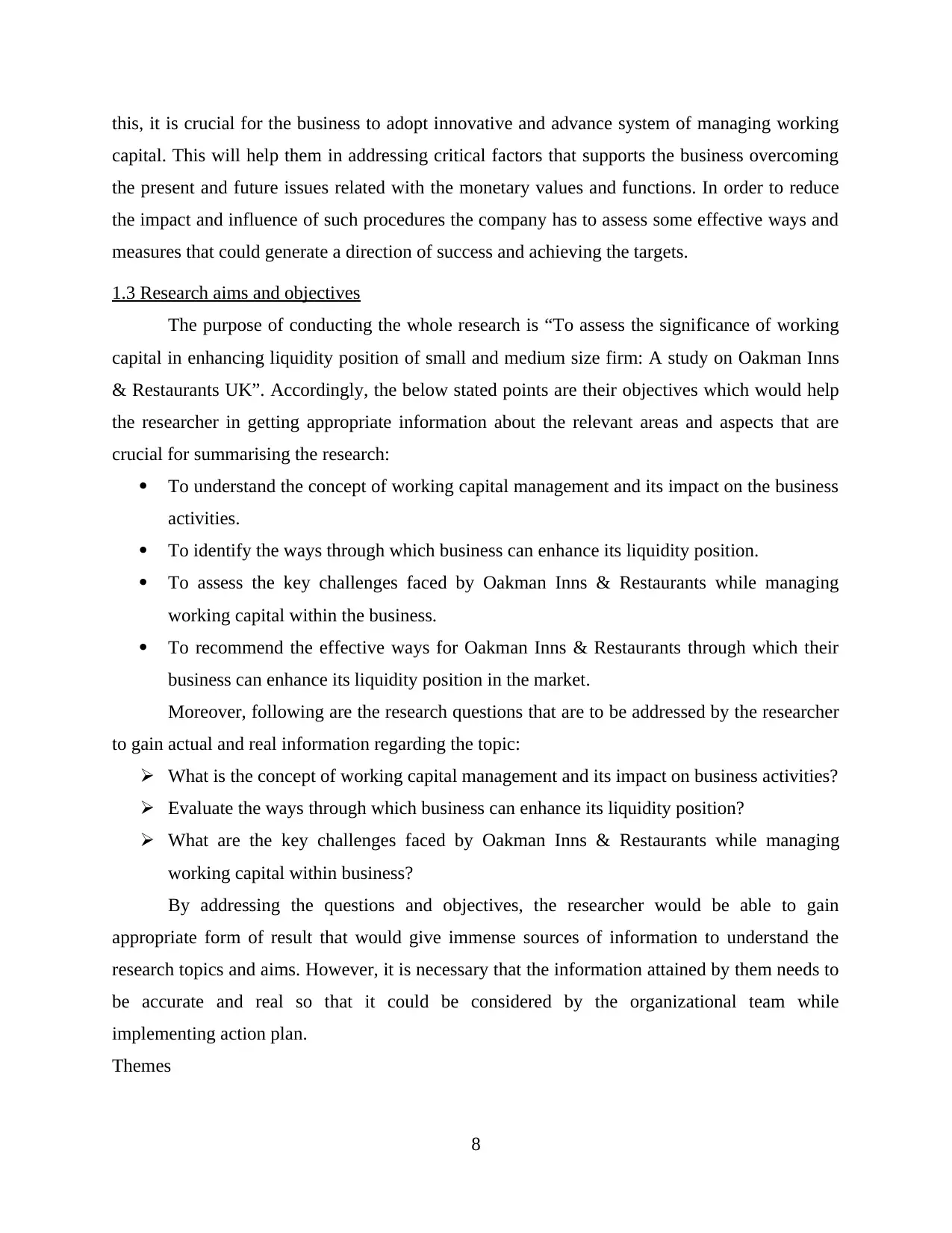
this, it is crucial for the business to adopt innovative and advance system of managing working
capital. This will help them in addressing critical factors that supports the business overcoming
the present and future issues related with the monetary values and functions. In order to reduce
the impact and influence of such procedures the company has to assess some effective ways and
measures that could generate a direction of success and achieving the targets.
1.3 Research aims and objectives
The purpose of conducting the whole research is “To assess the significance of working
capital in enhancing liquidity position of small and medium size firm: A study on Oakman Inns
& Restaurants UK”. Accordingly, the below stated points are their objectives which would help
the researcher in getting appropriate information about the relevant areas and aspects that are
crucial for summarising the research:
To understand the concept of working capital management and its impact on the business
activities.
To identify the ways through which business can enhance its liquidity position.
To assess the key challenges faced by Oakman Inns & Restaurants while managing
working capital within the business.
To recommend the effective ways for Oakman Inns & Restaurants through which their
business can enhance its liquidity position in the market.
Moreover, following are the research questions that are to be addressed by the researcher
to gain actual and real information regarding the topic:
What is the concept of working capital management and its impact on business activities?
Evaluate the ways through which business can enhance its liquidity position?
What are the key challenges faced by Oakman Inns & Restaurants while managing
working capital within business?
By addressing the questions and objectives, the researcher would be able to gain
appropriate form of result that would give immense sources of information to understand the
research topics and aims. However, it is necessary that the information attained by them needs to
be accurate and real so that it could be considered by the organizational team while
implementing action plan.
Themes
8
capital. This will help them in addressing critical factors that supports the business overcoming
the present and future issues related with the monetary values and functions. In order to reduce
the impact and influence of such procedures the company has to assess some effective ways and
measures that could generate a direction of success and achieving the targets.
1.3 Research aims and objectives
The purpose of conducting the whole research is “To assess the significance of working
capital in enhancing liquidity position of small and medium size firm: A study on Oakman Inns
& Restaurants UK”. Accordingly, the below stated points are their objectives which would help
the researcher in getting appropriate information about the relevant areas and aspects that are
crucial for summarising the research:
To understand the concept of working capital management and its impact on the business
activities.
To identify the ways through which business can enhance its liquidity position.
To assess the key challenges faced by Oakman Inns & Restaurants while managing
working capital within the business.
To recommend the effective ways for Oakman Inns & Restaurants through which their
business can enhance its liquidity position in the market.
Moreover, following are the research questions that are to be addressed by the researcher
to gain actual and real information regarding the topic:
What is the concept of working capital management and its impact on business activities?
Evaluate the ways through which business can enhance its liquidity position?
What are the key challenges faced by Oakman Inns & Restaurants while managing
working capital within business?
By addressing the questions and objectives, the researcher would be able to gain
appropriate form of result that would give immense sources of information to understand the
research topics and aims. However, it is necessary that the information attained by them needs to
be accurate and real so that it could be considered by the organizational team while
implementing action plan.
Themes
8
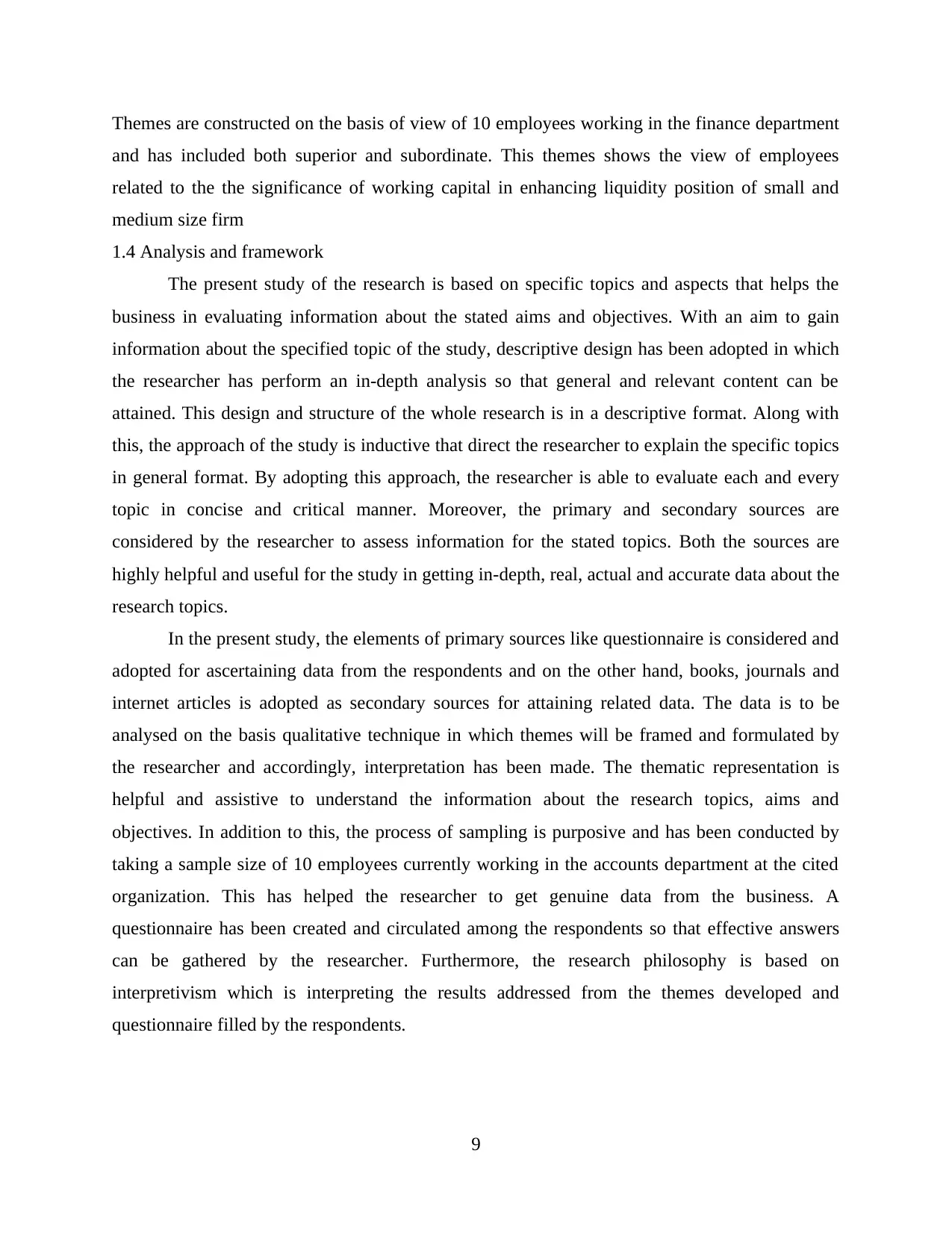
Themes are constructed on the basis of view of 10 employees working in the finance department
and has included both superior and subordinate. This themes shows the view of employees
related to the the significance of working capital in enhancing liquidity position of small and
medium size firm
1.4 Analysis and framework
The present study of the research is based on specific topics and aspects that helps the
business in evaluating information about the stated aims and objectives. With an aim to gain
information about the specified topic of the study, descriptive design has been adopted in which
the researcher has perform an in-depth analysis so that general and relevant content can be
attained. This design and structure of the whole research is in a descriptive format. Along with
this, the approach of the study is inductive that direct the researcher to explain the specific topics
in general format. By adopting this approach, the researcher is able to evaluate each and every
topic in concise and critical manner. Moreover, the primary and secondary sources are
considered by the researcher to assess information for the stated topics. Both the sources are
highly helpful and useful for the study in getting in-depth, real, actual and accurate data about the
research topics.
In the present study, the elements of primary sources like questionnaire is considered and
adopted for ascertaining data from the respondents and on the other hand, books, journals and
internet articles is adopted as secondary sources for attaining related data. The data is to be
analysed on the basis qualitative technique in which themes will be framed and formulated by
the researcher and accordingly, interpretation has been made. The thematic representation is
helpful and assistive to understand the information about the research topics, aims and
objectives. In addition to this, the process of sampling is purposive and has been conducted by
taking a sample size of 10 employees currently working in the accounts department at the cited
organization. This has helped the researcher to get genuine data from the business. A
questionnaire has been created and circulated among the respondents so that effective answers
can be gathered by the researcher. Furthermore, the research philosophy is based on
interpretivism which is interpreting the results addressed from the themes developed and
questionnaire filled by the respondents.
9
and has included both superior and subordinate. This themes shows the view of employees
related to the the significance of working capital in enhancing liquidity position of small and
medium size firm
1.4 Analysis and framework
The present study of the research is based on specific topics and aspects that helps the
business in evaluating information about the stated aims and objectives. With an aim to gain
information about the specified topic of the study, descriptive design has been adopted in which
the researcher has perform an in-depth analysis so that general and relevant content can be
attained. This design and structure of the whole research is in a descriptive format. Along with
this, the approach of the study is inductive that direct the researcher to explain the specific topics
in general format. By adopting this approach, the researcher is able to evaluate each and every
topic in concise and critical manner. Moreover, the primary and secondary sources are
considered by the researcher to assess information for the stated topics. Both the sources are
highly helpful and useful for the study in getting in-depth, real, actual and accurate data about the
research topics.
In the present study, the elements of primary sources like questionnaire is considered and
adopted for ascertaining data from the respondents and on the other hand, books, journals and
internet articles is adopted as secondary sources for attaining related data. The data is to be
analysed on the basis qualitative technique in which themes will be framed and formulated by
the researcher and accordingly, interpretation has been made. The thematic representation is
helpful and assistive to understand the information about the research topics, aims and
objectives. In addition to this, the process of sampling is purposive and has been conducted by
taking a sample size of 10 employees currently working in the accounts department at the cited
organization. This has helped the researcher to get genuine data from the business. A
questionnaire has been created and circulated among the respondents so that effective answers
can be gathered by the researcher. Furthermore, the research philosophy is based on
interpretivism which is interpreting the results addressed from the themes developed and
questionnaire filled by the respondents.
9
⊘ This is a preview!⊘
Do you want full access?
Subscribe today to unlock all pages.

Trusted by 1+ million students worldwide
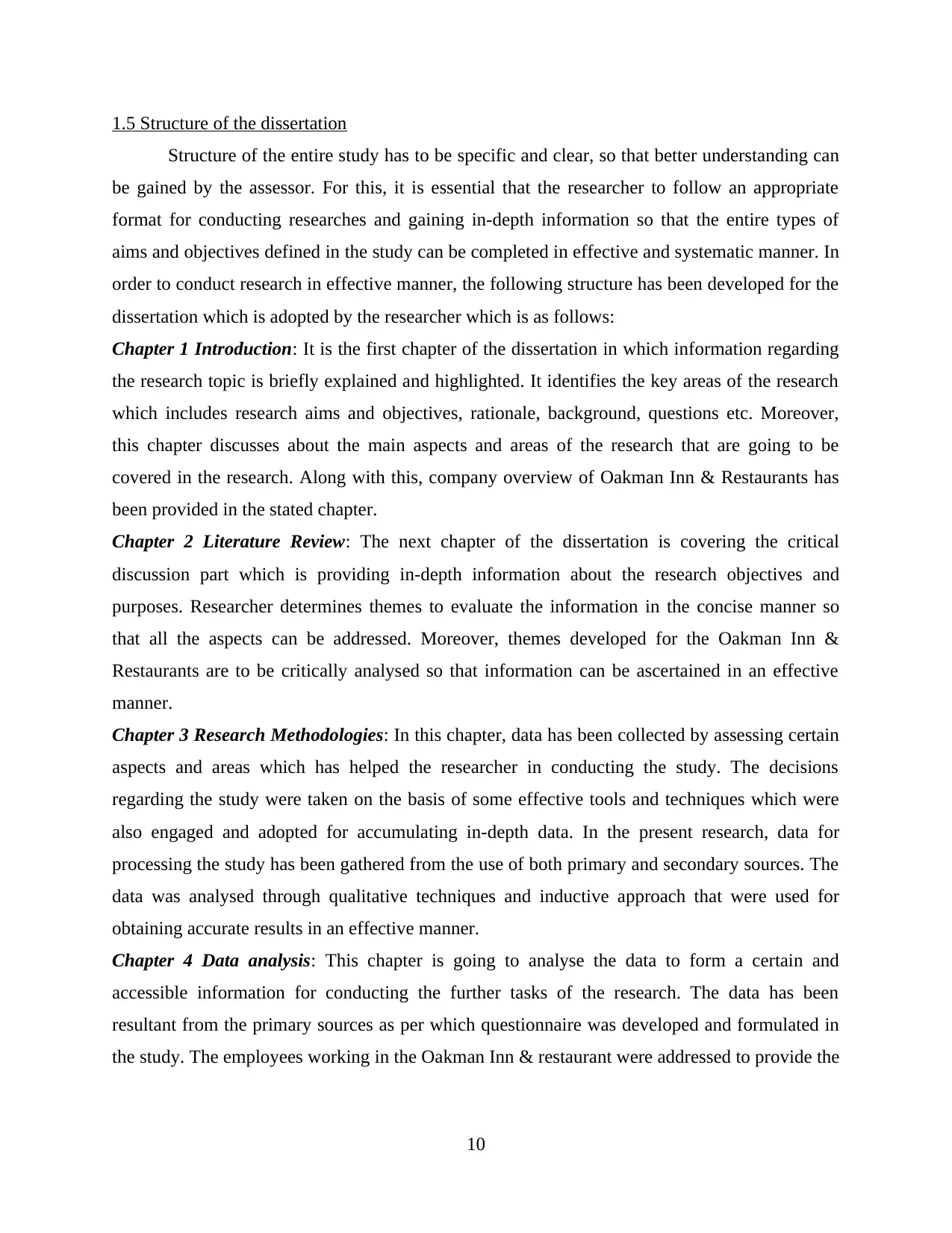
1.5 Structure of the dissertation
Structure of the entire study has to be specific and clear, so that better understanding can
be gained by the assessor. For this, it is essential that the researcher to follow an appropriate
format for conducting researches and gaining in-depth information so that the entire types of
aims and objectives defined in the study can be completed in effective and systematic manner. In
order to conduct research in effective manner, the following structure has been developed for the
dissertation which is adopted by the researcher which is as follows:
Chapter 1 Introduction: It is the first chapter of the dissertation in which information regarding
the research topic is briefly explained and highlighted. It identifies the key areas of the research
which includes research aims and objectives, rationale, background, questions etc. Moreover,
this chapter discusses about the main aspects and areas of the research that are going to be
covered in the research. Along with this, company overview of Oakman Inn & Restaurants has
been provided in the stated chapter.
Chapter 2 Literature Review: The next chapter of the dissertation is covering the critical
discussion part which is providing in-depth information about the research objectives and
purposes. Researcher determines themes to evaluate the information in the concise manner so
that all the aspects can be addressed. Moreover, themes developed for the Oakman Inn &
Restaurants are to be critically analysed so that information can be ascertained in an effective
manner.
Chapter 3 Research Methodologies: In this chapter, data has been collected by assessing certain
aspects and areas which has helped the researcher in conducting the study. The decisions
regarding the study were taken on the basis of some effective tools and techniques which were
also engaged and adopted for accumulating in-depth data. In the present research, data for
processing the study has been gathered from the use of both primary and secondary sources. The
data was analysed through qualitative techniques and inductive approach that were used for
obtaining accurate results in an effective manner.
Chapter 4 Data analysis: This chapter is going to analyse the data to form a certain and
accessible information for conducting the further tasks of the research. The data has been
resultant from the primary sources as per which questionnaire was developed and formulated in
the study. The employees working in the Oakman Inn & restaurant were addressed to provide the
10
Structure of the entire study has to be specific and clear, so that better understanding can
be gained by the assessor. For this, it is essential that the researcher to follow an appropriate
format for conducting researches and gaining in-depth information so that the entire types of
aims and objectives defined in the study can be completed in effective and systematic manner. In
order to conduct research in effective manner, the following structure has been developed for the
dissertation which is adopted by the researcher which is as follows:
Chapter 1 Introduction: It is the first chapter of the dissertation in which information regarding
the research topic is briefly explained and highlighted. It identifies the key areas of the research
which includes research aims and objectives, rationale, background, questions etc. Moreover,
this chapter discusses about the main aspects and areas of the research that are going to be
covered in the research. Along with this, company overview of Oakman Inn & Restaurants has
been provided in the stated chapter.
Chapter 2 Literature Review: The next chapter of the dissertation is covering the critical
discussion part which is providing in-depth information about the research objectives and
purposes. Researcher determines themes to evaluate the information in the concise manner so
that all the aspects can be addressed. Moreover, themes developed for the Oakman Inn &
Restaurants are to be critically analysed so that information can be ascertained in an effective
manner.
Chapter 3 Research Methodologies: In this chapter, data has been collected by assessing certain
aspects and areas which has helped the researcher in conducting the study. The decisions
regarding the study were taken on the basis of some effective tools and techniques which were
also engaged and adopted for accumulating in-depth data. In the present research, data for
processing the study has been gathered from the use of both primary and secondary sources. The
data was analysed through qualitative techniques and inductive approach that were used for
obtaining accurate results in an effective manner.
Chapter 4 Data analysis: This chapter is going to analyse the data to form a certain and
accessible information for conducting the further tasks of the research. The data has been
resultant from the primary sources as per which questionnaire was developed and formulated in
the study. The employees working in the Oakman Inn & restaurant were addressed to provide the
10
Paraphrase This Document
Need a fresh take? Get an instant paraphrase of this document with our AI Paraphraser

real and feasible information about the organization. The analysis has to effective and systematic
so that better understanding can be gained.
Chapter 5 Conclusion and recommendation: At the end, this chapter is going to conclude about
the entire information gained from the whole study. It has covered all the areas and aspects that
are discussed in the study and places a brief understanding about the research topics, aims and
objectives. Along with this, it has provided information about the recommendations regarding
the cited business which would help them in overcoming the issues and make effective measures
in gaining better results. It is crucial that the recommendation advised by the researcher needs to
be relevant and appropriate in order to consider as an effective medium of getting successful and
better results.
11
so that better understanding can be gained.
Chapter 5 Conclusion and recommendation: At the end, this chapter is going to conclude about
the entire information gained from the whole study. It has covered all the areas and aspects that
are discussed in the study and places a brief understanding about the research topics, aims and
objectives. Along with this, it has provided information about the recommendations regarding
the cited business which would help them in overcoming the issues and make effective measures
in gaining better results. It is crucial that the recommendation advised by the researcher needs to
be relevant and appropriate in order to consider as an effective medium of getting successful and
better results.
11
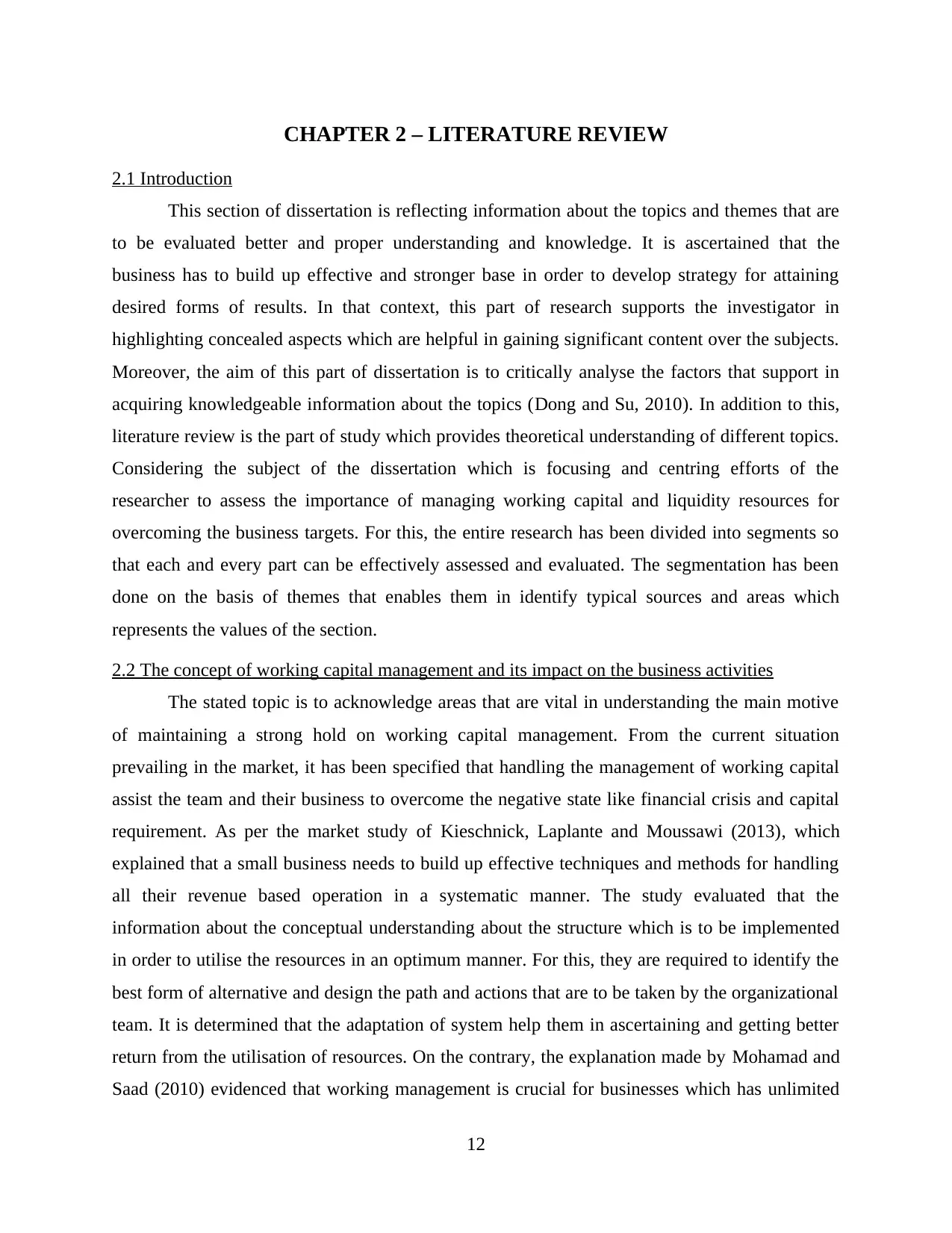
CHAPTER 2 – LITERATURE REVIEW
2.1 Introduction
This section of dissertation is reflecting information about the topics and themes that are
to be evaluated better and proper understanding and knowledge. It is ascertained that the
business has to build up effective and stronger base in order to develop strategy for attaining
desired forms of results. In that context, this part of research supports the investigator in
highlighting concealed aspects which are helpful in gaining significant content over the subjects.
Moreover, the aim of this part of dissertation is to critically analyse the factors that support in
acquiring knowledgeable information about the topics (Dong and Su, 2010). In addition to this,
literature review is the part of study which provides theoretical understanding of different topics.
Considering the subject of the dissertation which is focusing and centring efforts of the
researcher to assess the importance of managing working capital and liquidity resources for
overcoming the business targets. For this, the entire research has been divided into segments so
that each and every part can be effectively assessed and evaluated. The segmentation has been
done on the basis of themes that enables them in identify typical sources and areas which
represents the values of the section.
2.2 The concept of working capital management and its impact on the business activities
The stated topic is to acknowledge areas that are vital in understanding the main motive
of maintaining a strong hold on working capital management. From the current situation
prevailing in the market, it has been specified that handling the management of working capital
assist the team and their business to overcome the negative state like financial crisis and capital
requirement. As per the market study of Kieschnick, Laplante and Moussawi (2013), which
explained that a small business needs to build up effective techniques and methods for handling
all their revenue based operation in a systematic manner. The study evaluated that the
information about the conceptual understanding about the structure which is to be implemented
in order to utilise the resources in an optimum manner. For this, they are required to identify the
best form of alternative and design the path and actions that are to be taken by the organizational
team. It is determined that the adaptation of system help them in ascertaining and getting better
return from the utilisation of resources. On the contrary, the explanation made by Mohamad and
Saad (2010) evidenced that working management is crucial for businesses which has unlimited
12
2.1 Introduction
This section of dissertation is reflecting information about the topics and themes that are
to be evaluated better and proper understanding and knowledge. It is ascertained that the
business has to build up effective and stronger base in order to develop strategy for attaining
desired forms of results. In that context, this part of research supports the investigator in
highlighting concealed aspects which are helpful in gaining significant content over the subjects.
Moreover, the aim of this part of dissertation is to critically analyse the factors that support in
acquiring knowledgeable information about the topics (Dong and Su, 2010). In addition to this,
literature review is the part of study which provides theoretical understanding of different topics.
Considering the subject of the dissertation which is focusing and centring efforts of the
researcher to assess the importance of managing working capital and liquidity resources for
overcoming the business targets. For this, the entire research has been divided into segments so
that each and every part can be effectively assessed and evaluated. The segmentation has been
done on the basis of themes that enables them in identify typical sources and areas which
represents the values of the section.
2.2 The concept of working capital management and its impact on the business activities
The stated topic is to acknowledge areas that are vital in understanding the main motive
of maintaining a strong hold on working capital management. From the current situation
prevailing in the market, it has been specified that handling the management of working capital
assist the team and their business to overcome the negative state like financial crisis and capital
requirement. As per the market study of Kieschnick, Laplante and Moussawi (2013), which
explained that a small business needs to build up effective techniques and methods for handling
all their revenue based operation in a systematic manner. The study evaluated that the
information about the conceptual understanding about the structure which is to be implemented
in order to utilise the resources in an optimum manner. For this, they are required to identify the
best form of alternative and design the path and actions that are to be taken by the organizational
team. It is determined that the adaptation of system help them in ascertaining and getting better
return from the utilisation of resources. On the contrary, the explanation made by Mohamad and
Saad (2010) evidenced that working management is crucial for businesses which has unlimited
12
⊘ This is a preview!⊘
Do you want full access?
Subscribe today to unlock all pages.

Trusted by 1+ million students worldwide
1 out of 57
Related Documents
Your All-in-One AI-Powered Toolkit for Academic Success.
+13062052269
info@desklib.com
Available 24*7 on WhatsApp / Email
![[object Object]](/_next/static/media/star-bottom.7253800d.svg)
Unlock your academic potential
Copyright © 2020–2025 A2Z Services. All Rights Reserved. Developed and managed by ZUCOL.





